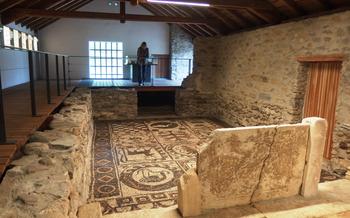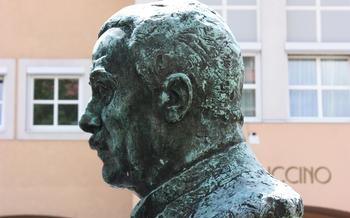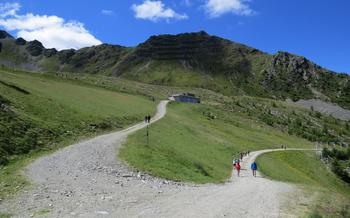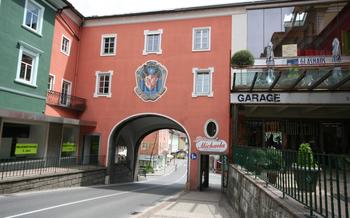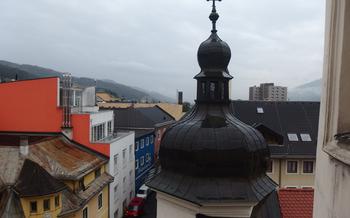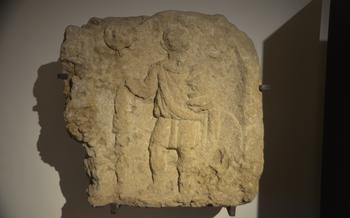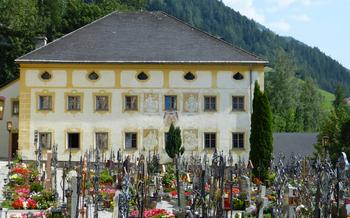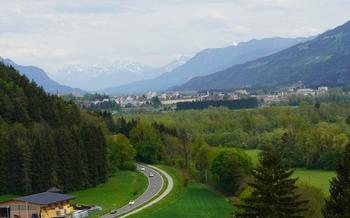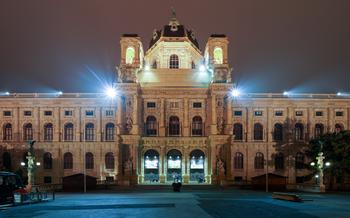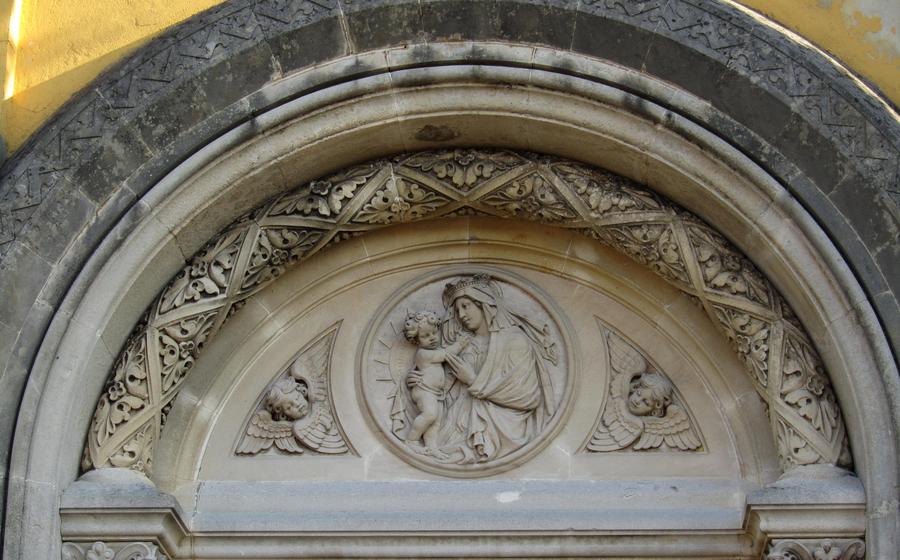
Roman Museum Teurnia
- Gmünd's Historical Significance
- Teurnia: A Glimpse into the Past
- Exploring the Roman Museum Teurnia
- Walking Through Time: The Archaeological Park
- Mosaics: A Masterpiece of Roman Art
- The Amphitheater: Echoes of Gladiatorial Contests
- The Temple District: A Place of Worship and Rituals
- The Roman Forum: Center of Public Life
- The Aqueduct: Engineering Marvel of Ancient Rome
- Everyday Life in Roman Teurnia
- The Fall of Teurnia: A Tale of Decline and Abandonment
- Rediscovering Teurnia: A Journey of Archaeological Exploration
- Teurnia Today: A Living Museum and Cultural Heritage Site
- Insider Tip: Uncovering the Hidden Treasure of Teurnia
Gmünd's Historical Significance
Gmünd, nestled in the heart of Carinthia, Austria, boasts a rich and storied past that dates back to the Roman era. Once a thriving Roman settlement known as Teurnia, the town played a pivotal role as the capital of the province of Noricum. Its strategic location at the crossroads of important trade routes made it a vital hub for commerce and cultural exchange. The town's significance was further enhanced by its proximity to the northernmost border of the vast Roman Empire, acting as a gateway to the untamed lands beyond. Gmünd's legacy extends beyond its Roman roots, with medieval fortifications and modern-day charm adding further layers to its captivating history.
Teurnia: A Glimpse into the Past
Teurnia, once a bustling Roman city, served as the capital of the province of Noricum, a region that encompassed parts of present-day Austria and Slovenia. This strategic location made Teurnia a crucial hub for trade and administration, connecting the Roman Empire to the northern regions of Europe. As the administrative center, Teurnia governed a vast territory, overseeing the collection of taxes, enforcing laws, and maintaining order.
Culturally, Teurnia flourished as a center of learning and artistry. It boasted temples dedicated to Roman deities, a forum where citizens gathered for public debates and market activities, and an amphitheater that hosted gladiatorial contests and other forms of entertainment. The city's wealth and prosperity attracted skilled artisans and craftsmen, who created exquisite mosaics, sculptures, and other works of art that adorned public buildings and private residences.
However, the glory of Teurnia was not to last. In the 5th century AD, the Roman Empire began to decline, and Teurnia suffered the same fate. The city was gradually abandoned as its inhabitants sought refuge from invading Germanic tribes. Over time, the once-magnificent city fell into ruin, its buildings crumbling and its treasures buried beneath layers of earth.
Centuries later, the forgotten city of Teurnia was rediscovered through archaeological excavations, revealing the remnants of its former grandeur. Today, the Roman Museum Teurnia stands as a testament to the city's rich history, inviting visitors to step back in time and explore the fascinating world of ancient Rome.
Exploring the Roman Museum Teurnia
The Roman Museum Teurnia, established in 1974, serves as a gateway to the rich history of Teurnia and the surrounding region. This state-of-the-art museum houses a vast collection of artifacts, meticulously unearthed during archaeological excavations at the site. Visitors can embark on a journey through time, witnessing the grandeur of the Roman Empire and its profound influence on this ancient city.
The museum's exhibits showcase an array of artifacts that provide a glimpse into the lives of Teurnia's inhabitants. From intricately carved sculptures and pottery to coins, tools, and jewelry, each artifact tells a unique story. The museum's curators have skillfully arranged these artifacts to create a comprehensive narrative of Teurnia's past, highlighting its significance as a cultural and administrative center.
In addition to its impressive collection, the Roman Museum Teurnia features interactive exhibits and educational programs that bring the history of Teurnia to life. Visitors can engage with hands-on activities, immersing themselves in the daily lives of the Romans. Whether it's learning about ancient construction techniques or trying on replicas of Roman clothing, these interactive experiences provide a deeper understanding of the Roman era.
Walking Through Time: The Archaeological Park
Teurnia's archaeological park invites visitors on a journey through time, enabling them to experience the grandeur and daily life of a once-thriving Roman city. The park's layout carefully incorporates the excavated ruins and foundations of various Roman structures, allowing visitors to visualize the city's original form.
As you stroll through the park, you'll encounter the remains of impressive public buildings, including temples, baths, and an amphitheater. The foundations and floor plans of these structures provide a glimpse into their original functions and dimensions. Scattered throughout the park are remnants of private dwellings, offering insights into the domestic life of Teurnia's inhabitants.
The park's design seamlessly integrates the excavated ruins with the surrounding landscape, creating a harmonious blend of history and nature. Visitors can wander along paths that wind through the archaeological remains, encountering remnants of ancient streets and plazas. Interpretive panels and signage provide informative context, explaining the significance of each structure and its role in the city's daily life.
Exploring the archaeological park is like taking a step back in time, immersing yourself in the atmosphere of a bygone era. As you traverse the paths, imagine the bustling streets filled with Romans going about their daily lives—traders bartering goods, artisans crafting their wares, and citizens attending to their civic duties. The park's immersive environment brings the ancient city to life, allowing visitors to connect with the past and gain a deeper understanding of Roman culture and civilization.
Mosaics: A Masterpiece of Roman Art
Mosaics, intricate artworks composed of small colored tiles, played a significant role in Roman culture, adorning floors and walls of public buildings, temples, and wealthy households. Teurnia boasts a remarkable collection of well-preserved mosaics, offering a glimpse into the artistic prowess of its inhabitants.
These mosaics showcase a variety of motifs, from geometric patterns to elaborate scenes depicting mythology, nature, and everyday life. The skill and precision with which the tesserae, or individual tiles, are arranged create lifelike and visually stunning compositions.
The techniques employed in creating these mosaics involved cutting and shaping small pieces of colored stone, glass, or ceramic into various forms. These tesserae were then arranged on a prepared surface, often a layer of mortar or cement, to form the desired design.
One of the most notable mosaics at Teurnia is the "Fish Mosaic," found in the ruins of a private house. It depicts a colorful array of fish swimming amidst aquatic plants, creating a vibrant and realistic underwater scene.
Another exquisite example is the "Hunting Mosaic," discovered in the ruins of a public building. It portrays a lively hunting scene, with dogs pursuing a deer through a forest. The intricate details and the use of shading techniques bring the scene to life, showcasing the artistry and storytelling abilities of the mosaicists.
These mosaics offer valuable insights into the artistic tastes and cultural influences of Roman Teurnia. They not only served as decorative elements but also conveyed messages and narratives, reflecting the beliefs, values, and daily life of the city's inhabitants.
The Amphitheater: Echoes of Gladiatorial Contests
At the heart of Roman entertainment stood the amphitheater, a majestic arena where the roar of the crowd mingled with the clash of steel. In Teurnia, the amphitheater served as a central venue for gladiatorial contests, showcasing the prowess and courage of these ancient warriors.
Built to accommodate thousands of spectators, the amphitheater's imposing structure reflected the grandeur of Roman architecture. Its elliptical shape and tiered seating ensured that every attendee had an unobstructed view of the bloody spectacles that unfolded within.
Gladiators, often slaves or condemned criminals, battled each other or wild animals for the amusement of the masses. These contests were not merely displays of violence but also tests of skill, strength, and determination. The victors were hailed as heroes, while the vanquished faced a grim fate.
Beyond gladiatorial combats, the amphitheater also hosted other forms of entertainment, including chariot races, acrobatic performances, and theatrical productions. It was a place where the citizens of Teurnia could escape the mundane and immerse themselves in a world of excitement and spectacle.
As the centuries passed, the amphitheater fell into disuse and ruin. Today, its remnants stand as a testament to the enduring legacy of Roman entertainment, offering visitors a glimpse into a world where blood, glory, and drama intertwined.
The Temple District: A Place of Worship and Rituals
Religion played a vital role in Roman society, and Teurnia was no exception. The city boasted several temples and shrines dedicated to various deities, each serving as a place of worship, prayer, and ritual. The Temple of Mithras, for instance, was dedicated to the Persian god Mithras, whose cult was popular among Roman soldiers. The temple featured a distinctive tauroctony relief, depicting Mithras slaying a bull, a symbol of his triumph over darkness.
Another significant temple was dedicated to the Egyptian goddess Isis, whose cult gained popularity throughout the Roman Empire. The Temple of Isis in Teurnia was likely a place of worship for merchants and travelers, who sought the goddess's protection during their journeys.
In addition to these temples, there were also smaller shrines dedicated to household gods, known as Lares and Penates. These shrines were often found in private homes and businesses, reflecting the importance of religion in everyday life.
The religious practices in Teurnia were diverse and included both public and private rituals. Public festivals and processions were held to honor the gods, while private rituals and prayers were performed within the temples and shrines.
Exploring the temple district of Teurnia offers a glimpse into the spiritual beliefs and practices of the Roman inhabitants, providing a deeper understanding of their cultural and religious heritage.
The Roman Forum: Center of Public Life
The Roman forum, known as the heart of ancient Roman cities, served as a central gathering place for the inhabitants of Teurnia. Located in the center of the city, the forum was a bustling hub of activity, serving various functions that shaped the social and political life of the Roman community.
The forum in Teurnia was a rectangular plaza surrounded by imposing public buildings, temples, and shops. Its layout reflected the Roman concept of urban planning, with wide, colonnaded streets leading into the square. The forum was paved with large stone slabs, ensuring easy movement and gatherings.
As the city's main public space, the forum hosted a variety of activities. Market trading was a common sight, with merchants from near and far displaying their wares to the local population. The forum also served as a venue for political debates, where citizens could voice their opinions and engage in discussions on matters affecting their community.
The Roman forum was not just a place of business and politics but also a center of social interaction. People from all walks of life gathered here to exchange news, gossip, and engage in lively conversations. It was a place where friendships were formed, alliances were forged, and the pulse of the city could be felt.
The Roman forum in Teurnia stood as a testament to the organizational skills and civic pride of its inhabitants. It was a place where the community came together to conduct business, engage in politics, and socialize, reflecting the vibrant and dynamic nature of Roman urban life.
The Aqueduct: Engineering Marvel of Ancient Rome
The Romans were renowned for their engineering prowess, and their aqueducts stand as a testament to their ingenuity and commitment to urban infrastructure. Teurnia was no exception, boasting an impressive aqueduct that supplied the city with fresh water from a distant mountain spring.
Constructed using a combination of stone, mortar, and terracotta pipes, the aqueduct stretched for several kilometers, traversing rugged terrain and valleys. Its route was carefully planned, with a gentle gradient that allowed water to flow smoothly and consistently. Along its course, the aqueduct featured numerous inspection chambers and reservoirs, ensuring a reliable water supply and facilitating maintenance.
The aqueduct's most remarkable feature was its ability to cross the Lieser River, a significant natural obstacle. To achieve this, the Romans constructed a series of sturdy stone arches, creating an elevated channel that carried water over the river's turbulent waters. This engineering feat not only showcased their technical expertise but also underlined the importance they placed on securing a dependable water source.
The aqueduct played a crucial role in the daily lives of Teurnia's inhabitants. It provided a steady supply of clean water for drinking, cooking, bathing, and irrigation, contributing to the city's overall sanitation and quality of life. Moreover, the aqueduct's presence allowed for the development of public fountains and elaborate bathing complexes, further enhancing the comfort and hygiene of the urban population.
Everyday Life in Roman Teurnia
Teurnia, as a provincial capital, was a bustling hub of activity with a diverse population representing various social classes and occupations. The upper echelons of society comprised wealthy landowners, merchants, and government officials, who often lived in luxurious villas adorned with mosaics and frescoes. In contrast, the majority of the population consisted of artisans, traders, and laborers, who lived in more modest dwellings.
Roman Teurnia was a patriarchal society, with the paterfamilias, or head of the household, wielding immense authority over his family. Extended families often lived together, and women were primarily responsible for domestic duties and raising children. Education was highly valued among the elite, and wealthy families employed tutors to teach their children literature, philosophy, and rhetoric.
For entertainment, the Romans enjoyed attending gladiatorial contests, chariot races, and theatrical performances. Public baths were also popular gathering places, where people could socialize, relax, and indulge in various bathing rituals. Religion played a significant role in everyday life, and the city was home to numerous temples and shrines dedicated to various deities.
The Fall of Teurnia: A Tale of Decline and Abandonment
The Roman Empire, once the epitome of power and civilization, succumbed to the inevitable forces of decline and fragmentation. This fate befell Teurnia as well, as it found itself caught in the maelstrom of political turmoil, economic instability, and barbarian invasions that plagued the empire in its waning years.
The city's strategic location, once its greatest asset, became a liability as Germanic tribes, lured by the riches within, repeatedly raided and pillaged Teurnia. The once-bustling metropolis gradually fell into disrepair and abandonment as its inhabitants sought refuge in more secure regions.
The final blow came in the 6th century AD when Slavic tribes, migrating westward, overwhelmed the weakened city. Teurnia was sacked and destroyed, its grand buildings reduced to rubble, and its once-vibrant streets fell silent. The once-glorious Roman city was left to the mercy of time and nature, its ruins slowly fading into oblivion.
Yet, despite its abandonment and decay, Teurnia's legacy lived on. Its ruins, though battered and worn, held within them the stories of a vanished civilization. Centuries later, archaeologists would meticulously sift through these ruins, piecing together the fragments of Teurnia's past and breathing new life into its forgotten history.
Rediscovering Teurnia: A Journey of Archaeological Exploration
The rediscovery of Teurnia is a captivating tale of archaeological intrigue and perseverance. The initial excavations, conducted in the late 18th century, revealed tantalizing glimpses of the city's past, sparking the curiosity of scholars and historians. However, it wasn't until the mid-19th century that systematic excavations began, led by the Austrian Archaeological Institute.
These early excavations unearthed a wealth of artifacts, including pottery, coins, and inscriptions, providing valuable insights into the city's history and culture. However, it was the work of subsequent archaeologists, particularly in the 20th century, that truly brought Teurnia to light.
Using advanced excavation techniques and interdisciplinary approaches, archaeologists meticulously uncovered the city's streets, buildings, and public spaces. The discovery of well-preserved mosaics, intricate sculptures, and monumental structures shed light on the grandeur and sophistication of Roman Teurnia.
The ongoing excavations at Teurnia are a testament to the enduring fascination with this ancient city. Each new discovery adds another piece to the puzzle, helping us to reconstruct the vibrant life that once thrived within these ruins.
Teurnia Today: A Living Museum and Cultural Heritage Site
Teurnia stands today as a testament to the enduring legacy of the Roman Empire. Its ruins, preserved within the archaeological park, offer a glimpse into the grandeur and complexity of a once-thriving city. Ongoing conservation and restoration efforts ensure that this precious heritage remains accessible and well-preserved for future generations.
The park's interactive exhibits and educational programs bring the past to life, allowing visitors to engage with the history and culture of Teurnia in a meaningful way. Guided tours led by knowledgeable experts provide deeper insights into the archaeological discoveries and the daily lives of the Roman inhabitants.
Teurnia transcends its role as a museum, becoming a living cultural heritage site. It hosts a variety of events, workshops, and festivals throughout the year, celebrating the region's rich Roman heritage. These events offer a unique opportunity to immerse oneself in the sights, sounds, and flavors of ancient Rome, creating a truly unforgettable experience for visitors of all ages.
Moreover, Teurnia's significance extends beyond its archaeological value. It serves as a reminder of the interconnectedness of European history and culture. The city's Roman roots have left an indelible mark on the region, influencing its architecture, language, and traditions. Preserving and promoting this heritage is essential to understanding and appreciating the cultural tapestry of modern-day Austria.
Insider Tip: Uncovering the Hidden Treasure of Teurnia
As you stroll through the ruins of Teurnia, keep an eye out for a hidden gem that often goes unnoticed by visitors: the remains of a Roman villa. Located on the outskirts of the city, this opulent residence offers a glimpse into the luxurious lifestyle of the Roman elite. With its intricate mosaics, frescoed walls, and well-preserved architecture, the villa provides a fascinating insight into the daily life of the wealthy citizens of Teurnia. Make sure to explore its various rooms, including the opulent dining hall, the cozy bedrooms, and the refreshing bathhouse. This hidden gem is a must-see for anyone interested in experiencing the grandeur of Roman living.
